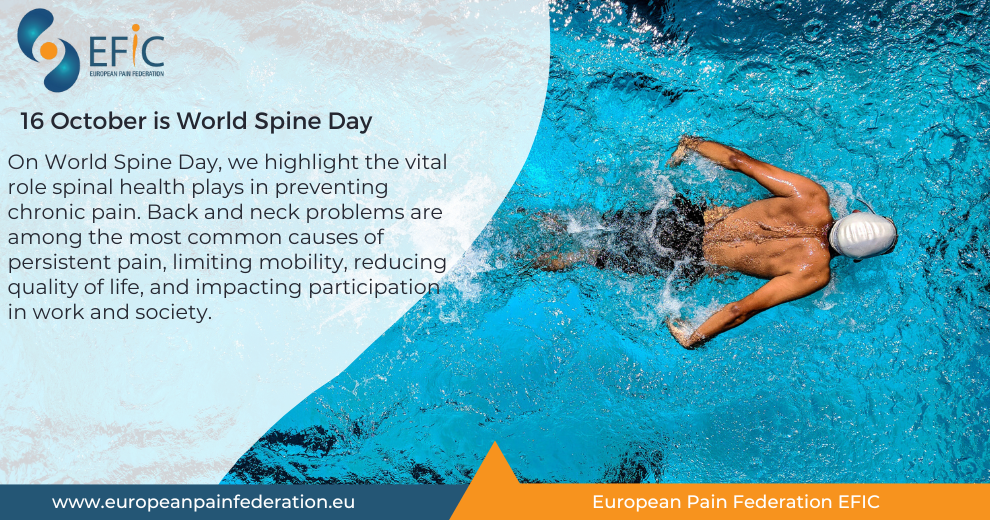About World Spine Day
October 16 is World Spine Day, the annual global initiative dedicated to drawing attention to spinal health and raising awareness of spinal pain and disability.
This year’s theme, “Invest in Your Spine”, emphasises the importance of prioritising spinal health through preventive care, education, rehabilitation and supportive environments.
Spinal pain (particularly low back pain) is the leading cause of years lived with disability globally. It affects people across all stages of life, is closely linked to work absenteeism, decreased quality of life, and significant economic burden.
World Spine Day calls on individuals, healthcare professionals, policymakers, employers, and communities to “Invest in Your Spine” by promoting healthy habits such as regular movement, correct ergonomics, posture awareness, and early intervention.
Official resources and toolkits for 2025 are freely available to support awareness efforts, educational events, and spinal health campaigns.
EFIC Initiatives on Pain & Spinal Health
At EFIC, we recognise the deep and oftentimes underappreciated link between spinal conditions and pain, both acute and chronic. Spinal pain is one of the most common contributors to chronic pain syndromes, and its effective management is essential for reducing suffering and improving functional outcomes.
In 2025, EFIC continues to promote cross-disciplinary collaboration between pain specialists, rehabilitation professionals, neurologists, and spine health experts to integrate evidence-based spinal care into broader pain management frameworks.
The EFIC Academy Education Platform includes modules and learning resources concerning spinal pain, posture assessment, ergonomics, and rehabilitation strategies for spinal pathologies. These materials support clinicians, physiotherapists, nurses, and other health professionals in delivering holistic, spine-informed pain care.
Additionally, through the Societal Impact of Pain (SIP) platform, EFIC advocates for policies that recognise pain, including musculoskeletal disorders, as a key contributor to disability and chronic pain burden: urging health systems to increase and improve pain prevention, management, treatment, and rehabilitation strategies.
EFIC On the Move – Linking Physical Activity and Pain Prevention
EFIC’s long-standing focus on physical activity as a cornerstone of pain prevention remains highly relevant to World Spine Day.
Physical activity’s well-known health benefits include reducing the risk of cancer, cardiovascular disease, diabetes, and improving mental health. What is less well known is that greater levels of physical activity and exercise are also associated with a lower risk of developing chronic pain. Chronic pain — defined as pain on a daily basis for 12 weeks or more — affects between 12–30% of Europeans.
The economic cost is enormous, amounting to 2.2% of GDP in Germany, 2.8% in Ireland, and 1.7% in the Netherlands through healthcare costs and lost productivity.
To address this, EFIC launched the “On the Move” Presidential Campaign (2017–2020), led by Past President Bart Morlion, emphasising the role of physical activity in preventing primary and secondary pain.
Campaign Milestones
-
2018: Brainstorm meeting in the European Parliament
-
2019: Collaboration with the European Region of the World Congress of Physical Therapy and presentation at the EFIC Congress
-
2019: Featured at the Societal Impact of Pain Symposium
-
2020: Integrated into the Global and European Year for Pain Prevention with IASP
-
Published article in the European Journal of Pain: “Physical activity should be the primary intervention for individuals living with chronic pain”
-
Development of an infographic and video to disseminate campaign messages (Infographic, Video)
Our call to action remains:
Healthcare professionals should advise patients on the importance of physical activity, empower them with knowledge in accessible language, and support them with environments and care plans that make sustainable lifestyle changes possible.
If you wish to use EFIC On the Move materials for your own campaign activities or request a translation, please contact: secretary@efic.org
Why Spinal Health Matters for Pain Management
-
Etiological overlap: Many chronic pain conditions (e.g. radiculopathy, degenerative disc disease, spinal stenosis) originate from spinal structures. Without proper spine-focused diagnosis and management, pain may persist or worsen.
-
Prevention and early intervention: Simple measures, like correct posture, ergonomics, physical activity, avoiding prolonged static postures, can reduce the risk of chronic spinal pain.
-
Rehabilitation synergy: Spinal rehabilitation (e.g. physiotherapy, movement therapies, ergonomic education) is an essential component in multimodal pain treatment pathways.
-
Economic & societal impact: Spinal pain contributes heavily to work incapacity and healthcare costs; mitigating its burden helps both patients and societies as a whole.
-
Key facts: Low back pain is a leading cause of disability, and an estimated one billion people worldwide experience some form of spinal pain.
How You Can Get Involved & Take Action
-
Use the 2025 World Spine Day toolkit and resources to host awareness events, educational sessions, or outreach campaigns.
-
Incorporate spinal health messaging and screening in your pain clinics or patient interactions.
-
Advocate for employer and institutional ergonomics, workplace posture policies, and supportive design of workstations.
-
Encourage patients and communities to engage in daily posture checks, movement breaks, back-strengthening exercises, and ergonomic habits.
-
Share your stories under #InvestInYourSpine to help spread awareness and build momentum.
